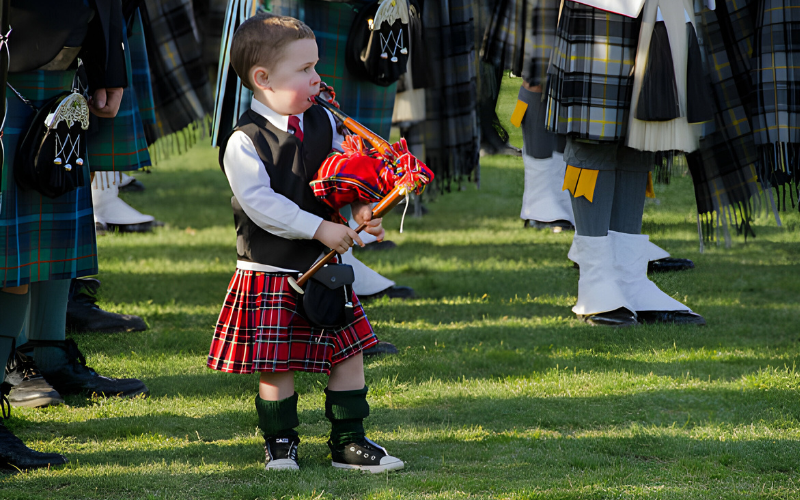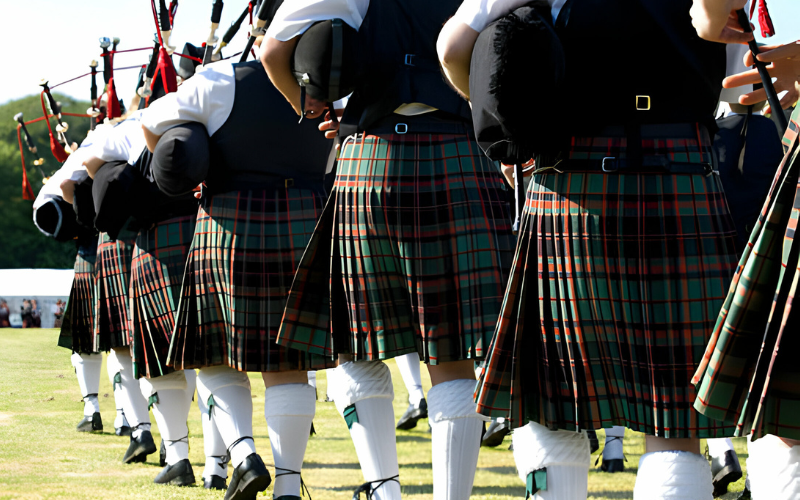The kilt, a traditional Scottish garment, stands as a symbol of pride and heritage. In this exploration, we delve into the very fabric of the kilt—its composition, history, and cultural importance. “What is a kilt?” you may ask. Let’s embark on a journey to uncover the intricacies of this iconic piece of clothing.
Historical Background
The kilt’s roots run deep in Scottish history, evolving from practical Highland attire to a cultural emblem. Originating in the 16th century, kilts were initially made from locally sourced materials, reflecting the region’s rugged landscape. Over time, kilts became not only a practical garment but also a potent symbol of Scottish identity.
As clans developed their distinct tartan patterns, kilts became a visual representation of familial and regional affiliations. The wearing of kilts was not merely a fashion choice; it was a statement of one’s heritage and allegiance to a particular clan. This deep connection between kilts and Scottish identity remains a defining characteristic, making the kilt more than just a piece of clothing.
What is a Kilt?
To answer the fundamental question, a kilt is more than just clothing; it encapsulates history, culture, and craftsmanship. “What is a kilt” encompasses not only its physical structure but also the emotions and traditions woven into every piece.
The term “kilt” refers to a knee-length garment with pleats at the rear, originating from the traditional Scottish dress. It is typically made of wool and adorned with tartan patterns, representing a specific clan or region. Beyond its material composition, the kilt holds immense cultural significance, serving as a symbol of Scottish pride and tradition.

Traditional Materials
Wool, a staple in Scottish textile heritage, plays a pivotal role in kilt construction. The intricate patterns of tartan, specific to clans and regions, add a layer of cultural significance. The wool used in kilts is often high-quality and sourced to ensure authenticity and durability. The weaving of tartan involves a meticulous process, with skilled artisans creating patterns that tell a story of lineage and heritage.
Leather and metal embellishments further contribute to the kilt’s distinctive appearance. Sporrans, small pouches worn at the front of the kilt, serve both practical and decorative purposes. Belts with ornate buckles, often featuring clan symbols, complete the ensemble, emphasizing the rich craftsmanship embedded in every kilt.
Modern Adaptations
In contemporary times, the definition of a kilt has expanded with the introduction of alternative materials. Synthetic fabrics provide durability and affordability, offering a modern twist to traditional kilts. Blends of wool and other fibers showcase the adaptability of this age-old garment to changing fashion trends and lifestyle needs.
While some purists may argue for the authenticity of traditional materials, modern kilts cater to a broader audience. They offer a range of choices, from lightweight and breathable options suitable for casual wear to more robust materials for formal occasions. The evolution of materials aligns with the evolving nature of fashion and allows kilts to remain relevant in diverse settings.
The Weaving Process
Understanding the kilt involves delving into the art of weaving. Traditional hand-weaving techniques, passed down through generations, continue to shape kilts today. The meticulous process of interlacing threads creates the distinctive patterns of tartan, each telling a unique story.
Mechanized weaving has streamlined production, making kilts more accessible to a broader audience. However, the essence of craftsmanship remains intact. Whether hand-woven or machine-made, kilts showcase the skill and dedication of those involved in their creation.
Construction Techniques
The artistry of a kilt lies in its construction. Tailoring and pleating methods, executed by skilled seamstresses and tailors, contribute to the garment’s distinct silhouette. The pleats, often hand-stitched to perfection, not only add to the visual appeal but also allow for ease of movement, reflecting the kilt’s origin as practical Highland wear.
The choice of construction methods can vary, with some kilts featuring knife pleats for a sharp and crisp appearance, while others may opt for box pleats, offering a different aesthetic. The craftsmanship involved in creating a well-fitted kilt reflects not just skill but a commitment to preserving a rich cultural legacy.
Care and Maintenance
Owning a kilt comes with responsibilities. Proper care ensures the longevity of this cherished garment. Cleaning guidelines vary based on materials, emphasizing the need for a tailored approach. Wool kilts may require more delicate handling, while synthetic blends may offer more flexibility in care.
Storage practices also play a vital role in preserving the kilt’s quality over time. Hanging kilts in a cool, dry place and avoiding prolonged exposure to sunlight or moisture are essential steps in maintaining their condition. With proper care, a well-made kilt can last for generations, becoming a treasured heirloom passed down through families.
Cultural Impact
The kilt’s impact extends beyond Scottish borders. Its significance in various events and ceremonies amplifies its cultural importance. Moreover, the kilt has seamlessly integrated into contemporary fashion, transcending its traditional roots to become a global style statement.
In Scotland, kilts are worn with pride during significant events such as weddings, ceilidhs, and formal gatherings. The sound of bagpipes accompanying a kilt-clad individual evokes a sense of tradition and festivity. The cultural impact of kilts reaches far beyond the shores of Scotland, with people worldwide embracing this distinctive garment as a symbol of connection to their roots or simply as a fashionable and unique piece of clothing.
Conclusion
In conclusion, the question “What is a kilt” unravels a tapestry of history, craftsmanship, and cultural richness. The kilt is not merely an ensemble; it is a representation of identity and tradition. As we navigate through its intricate weave, we realize that a kilt is more than just fabric—it is a story waiting to be told, a legacy to be embraced. So, the next time you ponder, “What is a kilt,” remember, it’s more than threads and fibers; it’s a symbol of heritage, resilience, and the enduring spirit of a culture.
FAQs
What is the significance of tartan patterns in kilts?
Tartan patterns are a crucial element of kilts, representing specific clans or regions in Scotland. They convey a wearer’s identity, reflecting their heritage and familial ties.
Are kilts still handmade using traditional techniques?
While modern technology has streamlined some aspects of kilt production, traditional hand-weaving techniques persist in crafting high-quality kilts. Many skilled artisans still contribute to the creation of these garments.
How should I care for my kilt to ensure its longevity?
Proper care involves understanding the materials used in your kilt. Follow specific cleaning guidelines based on the fabric, and store it in a cool, dry place to prevent damage.
Can kilts be worn for occasions other than traditional events?
Absolutely! Kilts have transcended their traditional roots and are now embraced in various settings, from formal events to casual gatherings. They have become a versatile and stylish wardrobe choice.
Do all kilts have specific cultural or regional significance?
While many kilts are tied to specific clans or regions in Scotland, contemporary kilts may not carry the same cultural weight. Some kilts are designed for fashion and personal expression rather than strict adherence to tradition.




Leave a reply